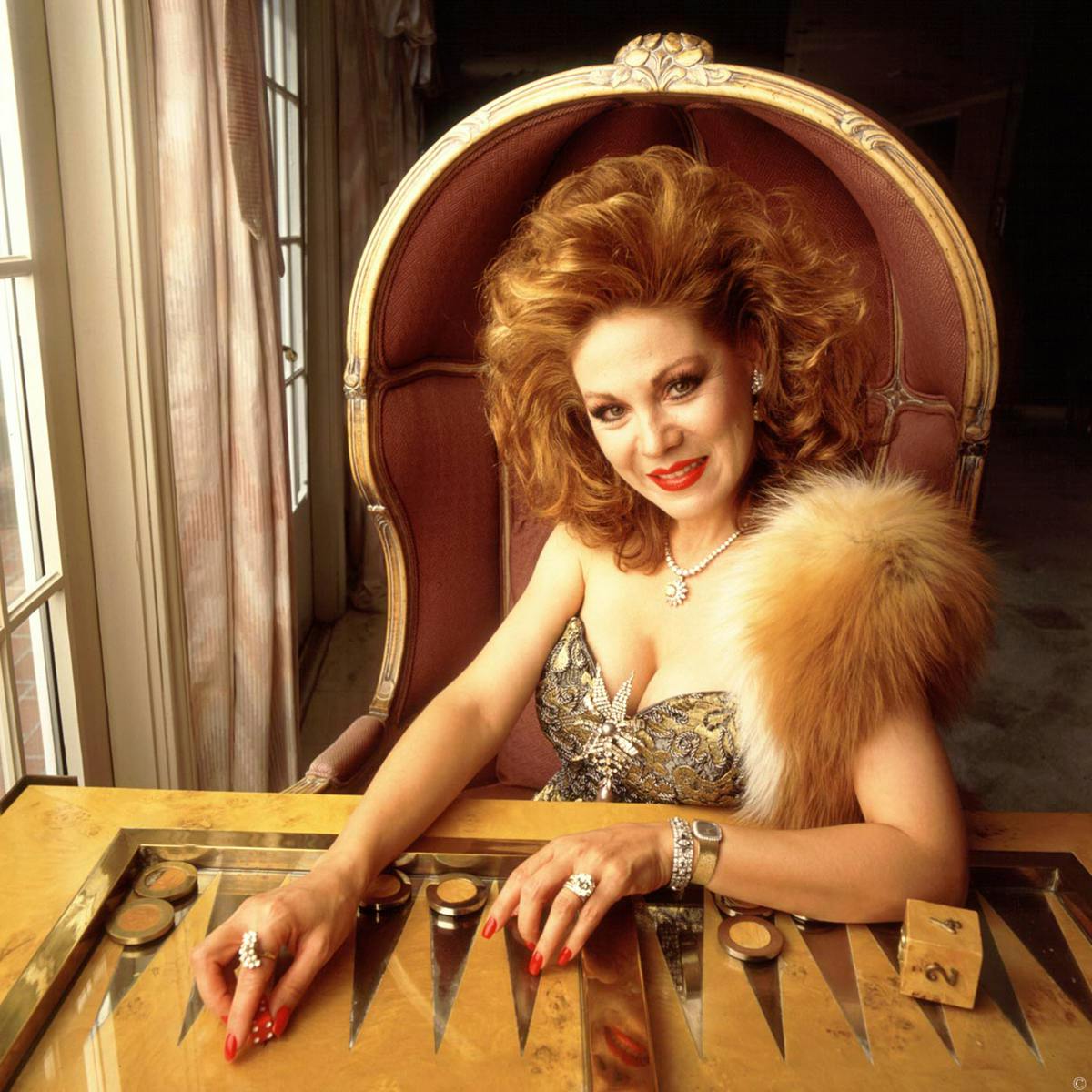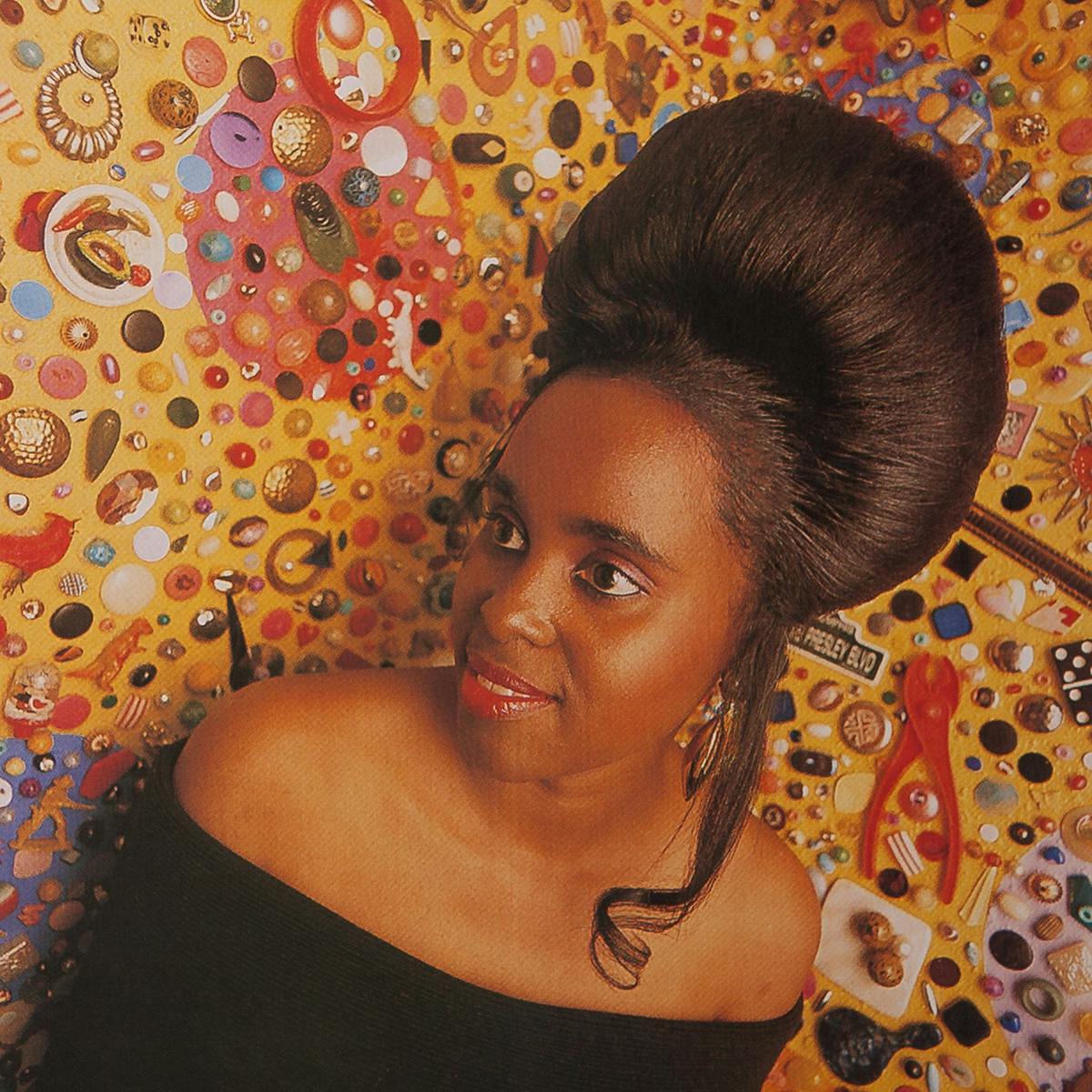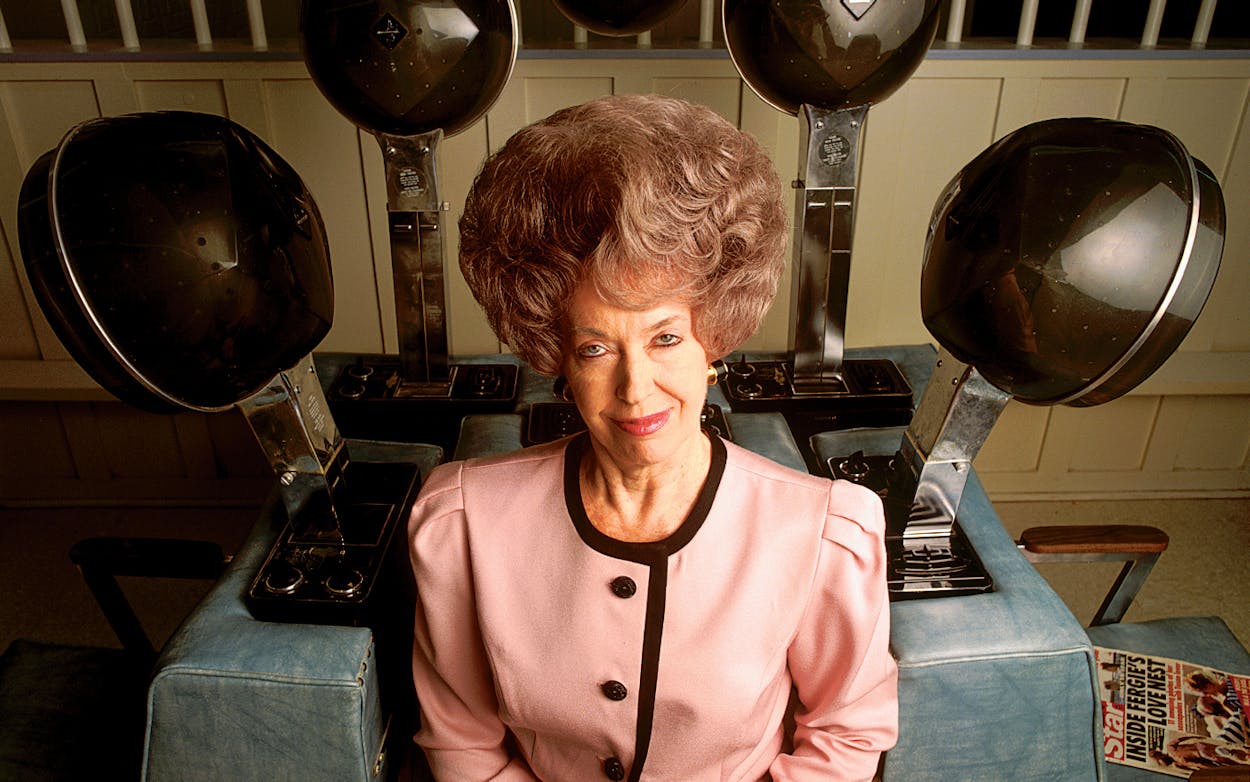It arrives like a blimp, floating ethereally through the door before the rest of the woman’s body does. For a moment, you can look at nothing else. You try to stare at the woman’s face, at her dress, even down at her shoes—but your eyes keep wandering upward. No matter how many times you’ve seen it, you find yourself once again awestruck by that towering, impenetrable edifice known as . . . Big Hair.
The most scorned fashion statement of our day, the target of rabid eradication campaigns by modern hairstylists, Big Hair hangs on like a buzzard in the desert. I, for one, am glad. At the risk of sounding socially impaired, I must confess that I love Big Hair.
I mean really big. I love the old-fashioned bouf-le-dos made popular again by Governor Ann Richards, and I love the wild curled-all-over hair of the Dallas Cowboy Cheerleaders. I love the way West Texas women can back-comb their hair until it looks like balls of tumbleweed, and I love the fluffy blond-tinted permed hair of big-city socialites. I love hair that looks like it’s exploding out of a woman’s head like a volcano, hair that stands on end as if it were trying to escape. I love the drama of simply standing next to a big-haired woman, wondering if the whole is going to collapse onto my face, cutting off my air supply, the fumes of her hair spray sliding up my nostrils and lodging forever in my brain.
And, thank God, I am lucky enough to live in Texas, the Big Hair Capital of the World. According to this year’s Glamour magazine survey of hairstyles around the country, “Everything’s larger than life in Texas.” This past summer, two anthropologists from Wayne State University in Detroit studied the importance of hair in American culture. Their findings? Sixty percent of women age 25 or older in Dallas wear some variation of Big Hair. “Dallas residents,” said the study, “linked hair loss with loss of power or opportunity in the workplace.” The distinguished Wall Street Journal, also feeling a need to weigh in on the issue, reported that Dallas women defiantly stand up to any stylist who wants to change the thick, molded “Dallas ‘do.” In fact, the internationally successful Vidal Sassoon salon closed soon after making a heralded move into Dallas in the mid-seventies because women hated its trademark short haircuts. “Some women, even today, come into my salon to get a chic contemporary cut,” says Paul Neinast, a well-known Dallas society hairdresser, “but when they head out to a big ball or party somewhere, they’ll fix their hair back into a big poufy hairdo.”
Says Perry Henderson, another Dallas society hairdresser of note: “A woman isn’t going to go to a party in an $8,000 suit, a $450 pair of shoes, and $75,000 worth of jewelry with hair that’s not done! Women who play golf don’t have big hair. Women who dress do.”

Big Hair, however, is not restricted to rich women who have a lot of time on their hands. Ladies who live in trailer homes on the edge of town still make weekly trips to the beauty shop for beehives. Post-punk girls who populate downtown nightclubs tousle and mousse their hair until it looks like a temper tantrum. Cool teenage Hispanic girls prefer Mall Bangs, in which one half of their bangs shoots straight up over their heads and the other half swoops down over their foreheads. Stern fundamentalist Christian women, dutifully following the Apostle Paul’s command in I Corinthians (“If a woman has long hair, it is a glory to her”), show up for church in plain high-necked dresses with great mounds of hair billowing around their heads like sheep. Every God-fearing Texas woman learned early in life the true significance of the Bible story in which Mary Magdalene was forgiven of her sins after drying Jesus’ feet with her hair. Mary Magdalene had Big Hair.
Everyone seems to have an idea about the origin of Texas Big Hair, known among some scientists as the Big Bangs Theory. Some say it started out of necessity in West Texas, where women needed a way to keep their hair in place when the wind blew. Not so, says Barbara Jenkins, an Austin hairdresser for eighteen years. Jenkins traces the roots of Texas Big Hair to a time when Texans started buying big Cadillacs. “Women started growing their hair out,” she says, “because they had a lot of room they could fill up in the front seat.” Wrong, says no less of an authority than Governor Richards’ salty hairdresser, Gail Huitt. “Honey,” she says, “Big Hair was created for one major reason. A woman learned that when her head was smaller than her butt, she looked deformed, like a marshmallow with an olive on top. Big Hair gives a gal proportion.” Others say that Big Hair caught hold in snooty society circles when Jacqueline Kennedy was seen wearing a back-combed big-haired style in the White House and that it prospered among the young when Elvis Presley married bouffant-wearing Priscilla. A new batch of Big Hair arrived in the seventies, when native Texan Farrah Fawcett showed up on Charlie’s Angels with massively teased hair.

Now, I know that fashion historians claim Big Hair’s glory days occurred in eighteenth-century France, when coifs were three feet tall, Madame de Pompadour was a European celebrity, and Marie Antoinette was said to have a headdress so high she couldn’t get into her carriage. But all that was only for show, height for art’s sake. What makes the Texas Big Hair phenomenon even more amazing is that it holds fast against trendiness. I have listened to people criticize a lot of things—politics, the salaries of sports stars, abstract art—but there is nothing like a woman without Big Hair complaining about a woman with Big Hair (“Ugh, beauty pageant hair!” “Soap opera hair!”). Indeed, those oh-so-progressive haut monde women—the kind who search for the meaning of life in fashion magazines—look at BHWs (Big-Haired Women) with a horror once reserved for the likes of Lee Harvey Oswald. Today Big Hair is equivalent to a bimbo badge. BHWs are regarded as social outcasts, women who overtly exaggerate their femininity and create spiderwebs out of their hair just to ensnare men. “Big Hair is all about abundance and sexuality,” says Julie Logan, Glamour’s West Coast editor. “It all gets down to sex, to what women think that men want.”
Oh, give me a break. There’s a lot of dyed-and-fried Big Hair that a man would not dare touch for fear of getting some permanent chemical stain on his hands. There’s lacquered “helmet hair” that a man could not touch even if he wanted to—hockey pucks couldn’t get through that stuff. Furthermore, after spending an afternoon at the salon, a BHW usually is not fond of the idea of some passion-stricken guy suddenly showing up to run his hands through his hair.
I am sure many women spend hours setting, perming, and waving their hair because it makes them feel attractive. For that we have the right to say they lead silly, empty lives? Good Lord, the one Texas woman who has advanced the cause of feminism in America, Sarah Weddington, the heroine of Roe v. Wade, has one of the puffiest crops of Big Hair I’ve ever seen. With the right stylist, she could probably make her hair swell to the size of an oil storage tank.The way I see it, women who load up their heads with hair are also loading themselves up with a kind of prestige. They’re not doing it to reassure men that they will always be girlish and nonthreatening. They are doing it to stand out. They refuse to be ignored. They will not give in to someone else’s idea of what is the fashionable style of the day. They are a proud, indomitable species. Isn’t it amusing that politically liberal women—they very ones you can usually count on to deride Big Hair—now find themselves clinging to Ann Richards’ old-fashioned Big Hair as a symbol of her solidity and strength? “Big Hair defies gravity,” says Gail Huitt, Richards’ hairdresser—and if big-haired women can defy gravity, she says, “there’s no telling what they can accomplish.”

Lamentably, in the past few years there have been major inroads made against Texas Big Hair. The economy, for one, has taken its toll. “In good-money times,” says Neinast, “you’re going to have a lot more parties, which naturally creates Big Hair. During a recession, women’s hair shrinks.” Moreover, a lot more Texas women have obviously been reading New York fashion magazines and opting for a different look. Despite Vidal Sassoon’s past failure, the relentlessly vogue English salon Toni and Guy came to Texas in 1985 and has expanded to ten locations in Dallas and Houston.
Yet just when we traditionalists think all might be lost, here come the major European and New York fashion designers, putting falls and wiglets and hair extensions on the models in their most recent runway shows. Some supermodels, such as Linda Evangelista, have even decided to start growing their hair out again. “We’ve now got teenage girls asking us to back-comb and back-brush their hair,” says Perry Henderson. “They want the French-twist look. They want us to use huge Velcro rollers in their hair.” Of course, top stylists aren’t calling this new look Big Hair, for fear of looking out-of-date. “We call it hair with volume,” sniffs Paul Joseph, the executive vice president of Toni and Guy.
The fact is, we will never be able to get away from Big Hair. As you can see from the photos in these pages, Big Hair has woven its way into our heritage; it has been passed down from generation to generation. Some of these women have worn their hair the same way for more than a quarter of a century. After all this time, their Big Hair remains a feast for the imagination.
Recently, I went to a campy Big Hair contest at the Red Lion Hotel in Austin, in which hairstylists from around the city had two hours to create the biggest, most astonishing hair possible. A few old-school Big Hair veterans were there, ratting and crimping and barrel-curling their models’ hair, but in one corner was a young stylist named Charon Bolin, wearing her own hair in a tightly clipped Twiggy-like fashion. “I’ve never, ever worn my hair big,” she told me firmly. “I’ve never even done a big-haired style before on a client.” She pursed her lips and blew on her model’s hair to dry the half can of hair spray she had just applied. “I don’t even know what I’m doing,” she murmured.
But as the evening passed, Bolin became more excited. Her model’s hair grew and grew. For a while, it resembled a martini glass, then a large fish. Finally, after using enough hair spray to wipe out a city the size of Amarillo, Bolin was finished. Her model looked like, well, a frizzed-out mermaid on acid.
Like Michelangelo stepping back to survey what he had done to the Sistine Chapel’s ceiling, Bolin stared at her massive work of art. A satisfied smile crossed her face. She sighed. “Well, I now know one thing,” she finally said. “The bigger your hair, the closer you are to God.”
To that, I can only say, “Amen.”
- More About:
- Style & Design
- Fashion









